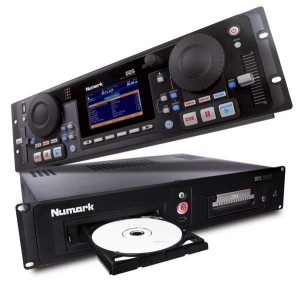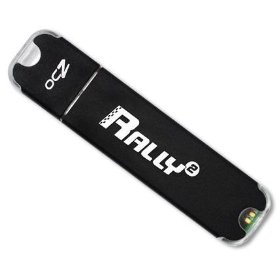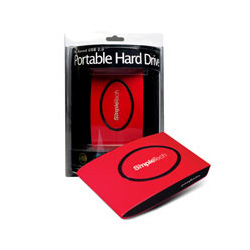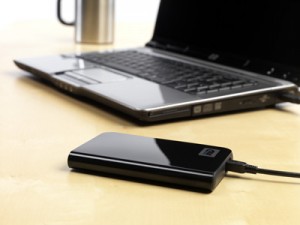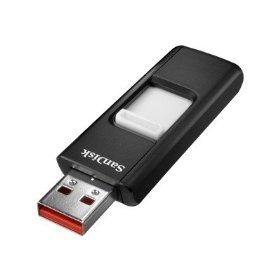Numark DDS80 Review
The Numark DDS 80What was appealing to me about this unit is that it was advertised as being “Future Proof” and able to accommodate a variety of music sources whether it be from external hard drive, USB flash drive, iPod, laptop, etc. The DDS controller has 3 USB ports which enable you to hook up, in theory, 3 additional music sources. In practice however, you will probably only have a single port available to you for additional music source since one port will be needed by the DVD-ROM/80GB hard drive unit, another port will be needed by the provided keyboard. This leaves only one more port available. To get around this limitation, you could of course use a powered USB hub to provide more ports, but this increases the odds of connection issues or problems, requires another power adapter in your setup (the DDS has it’s own plug and the DVD-ROM/hard drive unit also has it’s own power supply and plug). So before you know it, you’ve got power cords, power supplies and RCA cables to manage.
The DVD-ROM/hard drive unit also has a single USB port on the face of the unit, just below the power button.
The DDS80 has two of the USB ports located rather inconveniently on the back (Numark calls it the “front” of the unit in the description of the DDS80 but refers to it as the “back panel” in the documentation. Confusing? Yes it is? And misleading. If you intend to use flash drives as your primary source of music as I have chosen, this restricts the way in which you can place the controller in your equipment rack. For instance, if you prefer to have your mixer above the controller, then you will not be able to easily access the two USB ports on the back of the DDS controller. That menas you must have the DDS80 be above the mixer to enable easy access to the USB ports and that is not how I would prefer to have it be arranged. The DDS has the third USB port on the top left corner of the unit. I don’t find this particularly good placement either because if you have a flash drive plugged into that port, you end up having it sticking straight up, likely with a bright LED activity light on the flash drive blinking away all night long. It is very easy to bump it while working and most troublesome is its placement immediately adjacent to the jog/scratch wheel. It really gets in the way particularly when you are aggressively manipulating the jog/scratch wheel.. You could work around this somewhat by using a USB extension cable or the previously mentioned powered USB hub but that is not ideal.
The controls of the DDS80 will be familiar to most DJ’s. I actually am glad that Numark didn’t fill this device with a bunch of mostly useless special effects functions. What is included works well: pitch-shift (up to 25% and down to 100%), key lock, scratch, loop and really fast track lookup. For me, the key lock feature is incredibly useful. You can speed up a song without the key of the music changing and that means no more “chipmunks” vocals. You do have to use some discretion with this though because if you pitch a song down more than about 10% you start to get objectionable digital garbling. PItching up is more forgiving and the digital distortion is not nearly so noticeable. This is not a problem with the Numark, it is inherent in digital playback.
The scratch function works surprisingly well and if that’s you’re style, you will find it useful. The scratch wheel is not weighted though so it may or may not have the right “feel” for you.
At first glance a big disappointment for me was the loop function. You are limited to a single loop “in point” and it took a while for me to figure out how to micro-adjust the loop in and out points. Your first instinct is just to start the song and then hit the Loop In button at the point you want to start your loop and then hit the Loop Out button where you want to loop to end. This method is not all that accurate though. It’s all too easy to be a fraction of a beat off and that of course makes the loop sound terrible. But the secret is to pause the deck once you get to you the point where you’d like to start the loop, then use the jog wheel to get precisely where you want to be. Then hit your Loop In button. Start the song again using the play button and pause the song just about where you want the loop out point to be, then use the jog wheel to get to the precise out point and then hit the Loop Out button. This way you can get your loop exactly how you want it. Some loops are easier to set than others and you may not have to use the “precise” way every time, but it’s good to know that you can use that method if need be.
I was also happy to discover that once your music library has been run through the included Numark Librarian software, the music cues up in the player in an instant. It’s really really quick to load and that surprised me. However, be forewarned that you MUST have Numark Librarian create the library file or you will not be able to enjoy this lightning fast cue time since without the library file, the DDS takes much more time to load and discover the start point of the song. You’ll always want to run Numark Librarian on your music library since it also calculates the BPM of your songs among other things.
The Beatkeeper function is somewhat of a gimmick but I must say it does have some value. It’s virtually impossible to see in bright light though. So if you’re outside in bright light or inside in a brightly lit room doing a gig, you won’t be able to see the dimly lit LED’s for the Beatkeeper. But the intent of the Beatkeeper is to give a visual representation of the beat of the currently playing song as well as the beat of the song in the other deck. Thus it makes it possible to sync the two songs using only the visual aid provided by the Beatkeeper. Do I use it? No. Would I ever use it? Maybe. But most of the time I’m just going to beat-mix using the method I’ve always used and that is listening to my headphones and making the mix without the assistance of a flashing LED indicator.
Numark uses the Crate and Playlists to help you organize and put your most popular music into easily accessed “holding” areas. For instance you can make several playlists for “types” of music. As an example you could make one playlist for your top 10 songs and another playlist for your top 25 slow dance songs. You create a playlist by first naming the playlist then adding songs to the playlist from your music library on the DDS. The playlists are retained in the Library of whichever media device contains the Library from which the playlist was created and are available to you every time you turn on your DDS and mount the appropriate media device.
The DDS80 has not been a huge seller for Numark primarily because of the advent of competent software based laptop systems such as Serato. However for those DJ’s not wanting to deal with laptops and the hassles that can ensue using them, the DDS80 provides a robust solution that doesn’t take up a lot of space. You can pick up the Numark DDS 80 for under $800.
OCZ Rally2 8GB flash drive
I purchased two OCZ Rally2 8GB flash drives the other day from Amazon.. They were $19.95 each and they arrived today.They are constructed pretty well and have an aluminum housing that feels secure unlike the plastic housings that many other flash drives have. The cap does not particularly fit very snugly and when you take the cap off, it does not fit on the other end of the flash drive so you must be sure you don’t misplace the cap or you’ll lose it. And misplacing small caps must be relatively common because the OCZ website has a link to order replacement caps. Brilliant.
There is a bright orange LED activity light and it is extremely bright. I would say obnoxiously bright. When the drive is being accessed, the light flashes and in a dark room, with the flash drive plugged into the DDS80 on the top side of the controller, your rig looks like a blinking Christmas tree. I’ll be looking for some sort of cover to place over the flashing LED since it is so distracting.
Now let me talk about the wacky experience I had with the OCZ flash drive. I opened the package and put the drive into a USB port on my PC laptop. I loaded about 60 songs onto it and then ran the Numark Librarian software on it. I then plugged the drive into the DDS80 and it was mounted and seemed to work with no issues on the DDS80. I ejected the drive and then plugged it into my iMac with OS 10.5.7. It failed to mount. I ran Disk Utility and it was recognized in Disk Utility, but still would not mount. I attempted to Verify the drive, but it would not verify either. When I tried to format the drive in the iMac, I got an error that said the drive could not be unmounted. This was too weird and made no sense. I called OCZ tech support and they were not able to provide any useful advice except to say that I could return it for exchange.
I then took the drive back to the PC and reformatted it. Then I put it back in the iMac and this time it mounted with no problem. I loaded up some music onto it and basically filled it nearly to capacity and then ran Numark Librarian on it. It now seems to be fine on both the PC and the iMac as well as working in the DDS80.
I don’t feel very confident as to the reliability of it however since I had so many issues with it earlier in the day. I’ve got to say that the issue of bullet-proof reliability and performance with the DDS80 and flash drives is still very much up in the air. I am not anywhere near ready to entrust a Wedding to this equipment.
I’m tempted to order a 16GB and 32GB OCZ Rally2 flash drive to see if they will work in the DDS80. Since Numark isn’t apparently testing these various drives, someone might as well.
If you’ve had experience with any flash drives, please comment and include the manufacturer and size of the flash drive that you are using.
Numark’s response to my issues: None
My experience with Numark is taking a disappointing direction. I called Numark tech support two times this past Monday. I was told by both agents I spoke with that someone would be getting back to me later in the day. I never heard back from Numark.
I waited two more days and towards the end of today, decided to call Numark again to find out the status of my issues with the 16GB and 32GB Sandisk Cruzer flash drives that I blogged about. Their response was that the report I had made had been passed on to “technicians” and that’s all they had to say.
When I pressed for more information, none was given. When I asked to be connected with a technician, my request was denied. When I asked why I was told that the DDS80 should be able to work with -any- capacity flash memory card when in fact I have 3 cards that it won’t work with, I was told that Numark can’t possibly check the compatibility with every flash drive on the market. When I asked the agent how am I supposed to know what flash drive is compatible with the DDS80, he told me nothing of any value. In other words, you’re on your own apparently. If a flash drive works, then consider yourself lucky because Numark will provide no guidance whatsoever.
When I suggested that Sandisk is one of the largest producers of flash memory worldwide and that the Cruzer model is one of the largest selling flash memory drives and that maybe Numark should at least ensure compatibility with the market leading flash drive, I was told that the technicians have been notified and basically that’s it.
Is this good customer support? I would have to say no. This is my first Numark equipment purchase and my worst fears of not being able to trust Numark reliability are quickly becoming a reality.
With a handful of flash drives in my possession, only a couple of which work in the DDS80, I am completely unable to entrust any event to the unproven DDS80.
I will post more on this saga as more information becomes available.
Not all external USB hard drives are equal
I’ve had a Simpletech USB external hard drive for 2 years. It’s a smaller capacity drive, only 40GB. But it’s form factor is great. Cool looking and small. It is supposed to be bus powered, which it is, but the USB cable that comes with it has 2 USB plugs on it. Apparently the power requirements of the drive can not be met by all hardware. Count the Numark DDS80 as one of those pieces of equipment that cannot provide enough power to the Simpletech 40GB drive with only one USB plug. You’ll need to use up 2 of your USB ports on the DDS in order to power-up and operate the Simpletech hard drive. This may or may not be an issue for you, but if you intend to use a couple hard drives, either for redundancy or just because you have a large amount of music, you may find this limitation of the Simpletech frustrating. There is a DC power input on the drive, but I do not wish to have one more power adapter in my rack to provide power for this little drive. I have not yet tried a powered hub to see if that would provide enough power so that just one of the plugs would be needed. But as the price keeps dropping for these USB external drives, I may never get to that point. I paid $90 for the 40GB drive two years ago and just paid $79 for the 320GB Western Digital. I also own a 320GB Western Digital USB powered external hard drive, the My Passport Essential.Although it has 8x the capacity of the Simpletech, it only requires a single USB plug to power-up and operate. It seems to work just fine so far but to be honest, I have not had the DDS80 long enough yet to have had the time to put the WD hard drive through rigorous testing or usage. Just spending the little time with it so far that I have, has been trouble-free
Careful with what USB Flash Drive you choose
I’ve been having an extremely frustrating time getting SanDisk Cruzer 16GB and 32GB USB Flash Drives to work with the DDS80. The short story is that they do not seem to be compatible with the DDS80 whatsoever.I have purchased three of the SanDisk Cruzer flash drives. 1-16GB and 2-32GB. Both of these drives are formatted as FAT32 and mount properly on both my Apple iMac Desktop and PC Acer laptop. I am able to copy files to and from the flash drives with no issues on my computers. So I loaded them both with mp3’s and then ran the Numark Librarian software on both of them in order to create the Library that the DDS80 needs to enable you to search for music.
When I plug either of the 3 drives into either of the 3 USB ports on the DDS80, they do not mount and the DDS80 does not recognize them at all. The flash drive LED’s flash a few times then go into their “breathing” state where the LCD gently pulsates. But they do not mount and it is as if they weren’t plugged into the DDS80.
I thought that maybe the DDS80 USB port was underpowered and not able to provide enough current to the flash drive for it to function. To address that potential issue, I then plugged the USB drive into a powered USB Hub. That did not cause the flash drive to be recognized by the DDS80 either.
I called SanDisk and they told me that since the drives function properly in both my computers, that there is nothing wrong with the flash drives. They suggested that I try a powered hub with the DDS80, which I had already tried. They then suggested that the DDS80 firmware may not be able to handle high capacity flash drives. So I called Numark and spoke several times with technical support there. I am still waiting for their response but in my conversations, they claimed that they were not aware of any limitations of size of flash drive usage in the DDS80.
I have successfully been able to use a 2GB Lexar flash drive, a 2GB Sandisk Cruzer flash drive and a 2GB Macally flash drive. Unfortunately I do not have an 8GB flash drive to try.
So right now I’m stuck with 3 flash drives that do not work in the DDS80. Until Numark responds to my issue I would strongly recommend you stay away from SanDisk flash drives larger than 2GB in capacity until I get an authoritative answer from Numark.
If you’ve got any experience with larger capacity flash drives in the DDS80, please comment on this post. And be specific as to the brand and size that you are using. Any feedback would be greatly appreciated.
DDS80 Crate vs Playlist
One of the first things you need to get your head around with the DDS and DDS80 is the concept of the Crate and the Playlist.
The Crate harkens back to when DJ’s would have their vinyl in a plastic milk crate. Typically the DJ would pull out and rotate the albums that he was considering playing and leave them sticking out of the crate at an angle. Then as the gig progresses, it was easy for the DJ to flip through the pulled out albums to pick the next one for play.
The Crate takes this metaphor and applies it to the digital world. As you search for songs or scroll through your music files in the DDS LCD display, you select and send songs to the Crate. You are then able to view the Crate and see just the songs that you’ve selected. You can add more songs to the Crate as you think of them or remove songs from the crate if you change your mind. One thing to realize though is that once you send a song to a deck, it is removed from the Crate and will not be available to you unless you add it back to the Crate at a later time.
A Playlist, on the other hand, is a more permanent way to create a list of music. For instance, let’s say you have 20 songs that you like to play at just about every gig. You can create a playlist, name it what you want, then browse or search through your library and add songs to the playlist. The playlist is stored as part of the library and can be accessed indefinitely. Each playlist can then be sent to the Crate. This way you can always add easily add certain songs to your crate without having to go through your library time and time again adding songs to the crate.
One limitation of this implementation is that you cannot add your crate of music to an already created playlist. This is a big limitation because you could spend a lot of time sending songs to your Crate and then realize that the list of songs you compiled is a great list of music that you might like to save permanently as a playlist. Sorry, can’t be done!
DDS80 and FlashDrives
I took the plunge and bought the DDS80 last week. It’s been a rocky road. I have really mixed feelings about it and I will be discussing all my experiences with it in my blog.
My primary issue right now is that I purchased two 32GB Sandisk Cruzer flashdrives that won’t work with the DDS80. Read more


